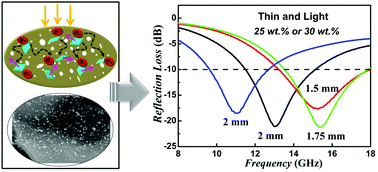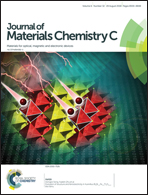Bio-gel derived nickel/carbon nanocomposites with enhanced microwave absorption†
Abstract
A bio-gel derived strategy was used to construct Ni/C nanocomposites consisting of three-dimensional (3-D) carbon networks with embedded nickel nanoparticles. The amorphous carbon prevents agglomeration of the nickel nanoparticles and thus contributes to a good impedance match. The microwave absorption properties of the Ni/C nanocomposites were optimized according to percolation theory for good impedance matching. As a result, microwave absorbing coatings, which have the advantages of thin thickness (1.75 and 1.5 mm) and light weight (25 and 30 wt%), were achieved with excellent absorbing properties (90% microwave absorption) and a broad bandwidth (13.6–18 GHz and 13.2–18 GHz). The absorbing properties were mainly attributed to the dielectric relaxation processes at 2–18 GHz from the multilevel interface, porous carbon materials and nanoscale nickel nanoparticles in the Ni/C nanocomposites. It is believed that this work not only helps to elucidate the mechanism of absorption but also provides a new design paradigm for determining the optimal content of absorbers using percolation theory. The bio-gel derived strategy paves a possible way for the mass synthesis of microwave absorbers.



 Please wait while we load your content...
Please wait while we load your content...